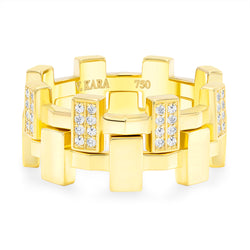I recently came across an ad from a jewelry brand claiming their gold-plated pieces were “waterproof,” and honestly, I couldn’t believe my eyes. As someone who lives and breathes fine jewelry, I’ve seen my fair share of marketing gimmicks, but this one really struck a nerve. It’s misleading, plain and simple—and it’s time to set the record straight.
Here’s the thing: jewelry isn’t technically “waterproof.”
What Does “Waterproof” Even Mean for Jewelry?
When you hear “waterproof,” you might think of a piece you can wear in the shower, swimming pool, or ocean without a second thought. But the reality is much more complicated. Different materials react to water in different ways, and the term “waterproof” is really just a marketing ploy when it comes to most jewelry—especially gold-plated pieces.
Gold-Plated Jewelry: A Recipe for Disappointment
Let’s talk about gold plating. These pieces are made by coating a base metal (like brass or stainless steel) with a thin layer of gold. While they look beautiful initially, that gold layer is incredibly delicate. Over time—and especially with water exposure—it will wear off, leaving the base metal exposed.
Water can also accelerate tarnishing, causing the jewelry to lose its shine and even turn green. And don’t even get me started on saltwater or chlorine; those are like kryptonite for gold-plated pieces. So, no—gold-plated jewelry is not waterproof, and anyone claiming otherwise is selling you a fantasy.
The Reality of Fine Jewelry and Water
Even high-quality materials like solid gold, platinum, and stainless steel aren’t truly “waterproof.” They’re more water-resistant, meaning they can handle occasional exposure without immediate damage. However, prolonged exposure to water—especially harsh elements like chlorine or salt—can weaken even the most durable pieces.
And if your jewelry has gemstones or pearls? Forget about it. Many stones, like opals and turquoise, are porous and can be damaged by water. Pearls, meanwhile, are extremely sensitive to moisture and can lose their luster.
How to Protect Your Jewelry
So, what’s the takeaway here? Care for your jewelry like the treasure it is.
• Remove it before swimming or showering.
• Store it in a dry, safe place when not in use.
• Invest in high-quality materials like solid gold or platinum if you’re looking for durability.
Why Honesty Matters
At my jewelry brand, transparency is non-negotiable. I believe in educating customers, not misleading them with flashy buzzwords. That's why I design pieces made to last and always provide clear care instructions.
Because here's the truth: Jewelry is an investment and taking care of it is part of the deal. It's not about selling you on the idea that you can wear a gold-plated necklace while doing laps in the pool - it's about creating pieces you'll cherish for a lifetime.
The next time you see a brand claiming their jewelry is "waterproof", remember this: It's marketing, not reality. Don't fall for the scam - invest in quality and take care of your sparkle.
Ready to shop fine jewelry designed to last? Explore our collection of solid 18 karat gold pieces and build your Fortress of timeless elegance. Click here to shop.



Leave a comment